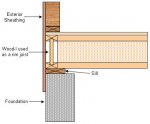Yes you can staple nm to the bottom of the joist along its length. Show me where it says you can't and don't use authority having jurisdiction discretion because that is open to anything. The bottom of the joist is along the building surface.
A joist is a framing member.
334.17 Through or Parallel to Framing Members. Types
NM, NMC, or NMS cable
shall be protected in accordance
with 300.4 where installed through or parallel to framing
members.
300.4
(D) Cables and Raceways Parallel to Framing Members
and Furring Strips. In both exposed and concealed
locations, where a cable- or raceway-type wiring method is
installed parallel to framing members, such as joists,
rafters, or studs, or is installed parallel to furring strips, the
cable or raceway shall be installed and supported so that the
nearest outside surface of the cable or raceway is not less
than 32 mm (11?4 in.) from the nearest edge of the framing
member or furring strips where nails or screws are likely to
penetrate. Where this distance cannot be maintained, the
cable or raceway shall be protected from penetration by
nails or screws by a steel plate, sleeve, or equivalent at least
1.6 mm (1?16 in.) thick.


